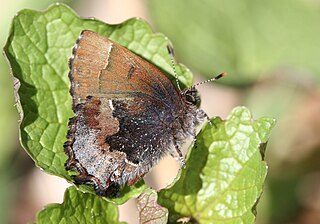
Grass skippers or banded skippers are butterflies of the subfamily Hesperiinae, part of the skipper family, Hesperiidae. The subfamily was established by Pierre André Latreille in 1809.

Pyrginae, commonly known as spread-winged skippers, are a subfamily of the skipper butterfly family (Hesperiidae). The subfamily was established by Hermann Burmeister in 1878. Their delimitation and internal systematics has changed considerably in recent years, but as of 2009 the uncertainties surrounding the evolutionary relationships of many genera in this subfamily are widely resolved.

The Zabulon skipper is a North American butterfly first described by the French naturalists Jean Baptiste Boisduval and John Eatton Le Conte from the state of Georgia, United States.

Atalopedes campestris is a small grass skipper butterfly. It has a wingspan of 35–41 mm. Male is orange, edged with brown, and has a large brown-black stigma. Female is darker with lighter markings in the center of the wing.

The pearl crescent is a butterfly of North America. It is found in all parts of the United States except the west coast, and throughout Mexico and parts of southern Canada, in particular Ontario. Its habitat is open areas such as pastures, road edges, vacant lots, fields, open pine woods. Its pattern is quite variable. Males usually have black antenna knobs. Its upperside is orange with black borders; postmedian and submarginal areas are crossed by fine black marks. The underside of the hindwing has a dark marginal patch containing a light-colored crescent.

The Eudaminae are a subfamily of skipper butterflies. Their original type genus Eudamus is today a junior synonym of Urbanus. They are largely found in the Neotropics, with some extending into temperate North America and the puzzling Lobocla occurring in East Asia.

Burnsius communis, the common checkered-skipper, formerly known as Pyrgus communis, is a species of butterfly in the family Hesperiidae. It is known as the frequently seen Pyrginae species in the northern United States by collectors and watchers alike.

Nathalis iole, the dainty sulphur or dwarf yellow, is a North American butterfly in the family Pieridae.

Autochton cellus, the golden banded-skipper, is a North and Central American butterfly in the family Hesperiidae. There are two populations, one in the eastern United States and the other in the southwestern United States and Mexico. The eastern population is rare and local and uses only one host plant, the thicket bean. The southwestern population is uncommon to common and uses more than one host plant. The golden banded-skipper is most active mid-morning and late afternoon. Their flight is sluggish and low to the ground, compared to closely related species.

Ancyloxypha numitor, the least skipper, is a North American butterfly in the family Hesperiidae. They have a weak, Satyrinae-like flight.

Polites themistocles, the tawny-edged skipper, is a North American butterfly in the family Hesperiidae.

Autochton is a genus of skipper butterflies. They belong to the subfamily Eudaminae, which was long included with the spread-winged skippers (Pyrginae) as a tribe. They are found from Mexico to South America.

Callophrys henrici, the Henry's elfin or woodland elfin, is a North American butterfly in the family Lycaenidae. In Canada it is found from southern Manitoba to southern Nova Scotia. It has two main groups of populations in the United States; the first is found along the Atlantic Coast and uses various hollies (Ilex) as host plants; and the second is found mainly in the north and the Appalachians where they use redbud as a host plant. Henry's elfin is increasing in New England because of an introduced buckthorn it now uses as a host plant. It is listed as a species of special concern in the US state of Connecticut.

Achalarus is a genus of skippers in the subfamily Eudaminae. The species range from eastern United States to Venezuela.

Polites vibex, or the whirlabout, is a grass skipper in the family Hesperiidae. The whirlabout gets its name from the landing and take off flight patterns of the adult – a circular or vortex or whirling motion. It is resident from the southeastern U.S. and West Indies to eastern Mexico through the tropics down to Argentina. During the warmer North American months, it can sometimes be found as far north as Ohio, Connecticut, and northeast Iowa.

















